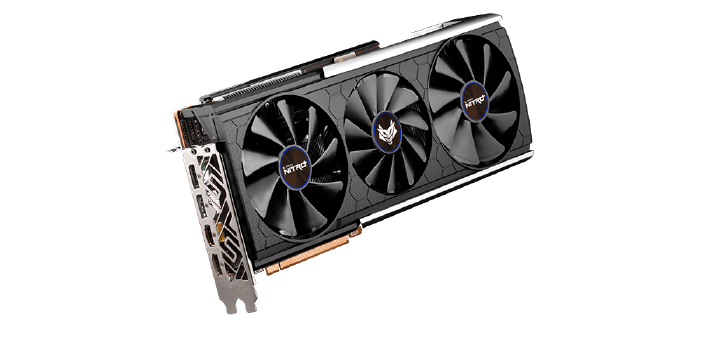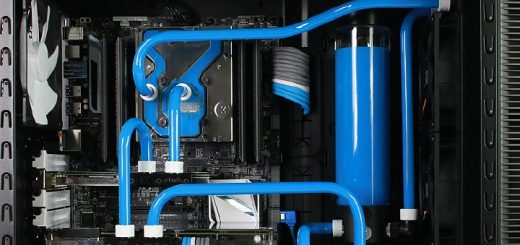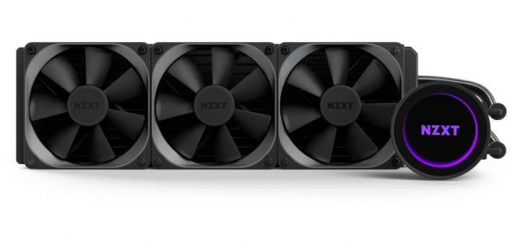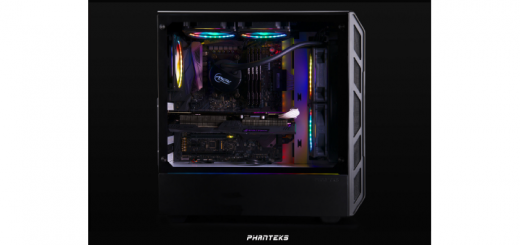Sapphire RX 5700 XT Nitro+ has been introduced by the company officially. Its release follows the emergence of a listing on an online retailer a few days back. The graphics card carries a price tag of $440 (USD). It is a triple-fan card with a black and silver shroud that will appeal to most users.
Sapphire RX 5700 XT Nitro+ Design and Dimensions
Sapphire RX 5700 XT Nitro+ features the Tri-X cooling solution from the company. It is their top-of-the-line custom cooling solution at the moment. It is 305mm long (over one foot) and has a triple-slot design with 48mm of thickness and 120mm width.
The top of the card, including the fans, is mostly black while the silver color dominates the sides. It looks aesthetically pleasing without being overdone. Its rear I/O has a pair of HDMI connectors and another pair of Display ports (1.4) for connecting devices. The user-facing side of the Sapphire RX 5700 XT Nitro+ graphics card illuminates the company’s name using RGB LEDs. An RGB LED strip on the backplate is also visible from the side. Its aluminum backplate has an attractive silver finish with black highlights and cutouts for an aesthetically appealing design.
Its heat sink extends beyond the PCB of the card. Actually, there are two separate heatsinks on the Sapphire RX 5700 XT Nitro+ – a large one for the GPU and a small one for the memory modules and VRM. The smaller heatsink has its own fins for cooling. The main GPU heatsink has a copper base plate and five full-length copper pipes plated with nickel for superior cooling. There is an additional aluminum baseplate with thermal pads attached to the main heatsink for cooling VRM components.
The card comes with three fans – two larger 92mm fans on the sides and a smaller 85mm one in the center. The center fan rotates in the opposite direction to the two larger ones for boosting airflow and thermal performance. It reduces the noise produced by the fans as well because they don’t have to spin at higher RPMs for keeping the card cool.
Sapphire RX 5700 XT Nitro+ Features

The aluminum backplate of the Sapphire RX 5700 XT Nitro+ graphics card features an RGB LED illuminated NITRO logo. There is a three-pin header on the card that allows you to sync the LEDs of the card to other components via the motherboard’s software. You will have to connect the graphics card RGB header to an RGB header on your motherboard for the same.
An important highlight of the Sapphire RX 5700 XT Nitro+ graphics card is its user-replaceable clip-in fans. The fans of the card are easily replaceable and require the removal of just one screw. You don’t have to RMA the whole card in case one of the fans die. You can remove the fan and get a new one from Sapphire. Sapphire’s fan testing feature in its Trixx software assists in determining if the fan is faulty.
The stock fans on the card are non-RGB versions. If you don’t like the look of the black stock fans, you can upgrade them to colorful ones. You can purchase an add-on bundle that includes three ARGB fans with transparent blades. It will set you back by an additional $30. You can replace the stock fans on the Sapphire RX 5700 XT Nitro+.
The Sapphire RX 5700 XT Nitro+ features a triple BIOS switch as compared to other custom models that mostly have a dual BIOS switch. The default VBIOS mode is high-performance while the second mode is silent. The third software VBIOS mode also allows you to load any of the other two BIOS profiles via the Trixx software. You don’t have to flip the BIOS switch manually. Any changes you make will be saved in the third profile while the default two profiles remain intact. It will provide extra safety cushioning to overclockers and modding enthusiasts.
Sapphire RX 5700 XT Nitro+ Specifications

Sapphire RX 5700 XT Nitro+ graphics card comes overclocked out of the box. It is one of the fewer custom models to feature higher clock speeds than the reference cards. It has a base clock of 1770 MHz and a game clock of up to 1905 MHz. The boost clock is also higher at 2010MHz. In comparison, AMD’s RX 5700 XT reference GPUs have a base clock of 1605 MHz, a game clock of 1755MHz and a boost clock of 1905MHz. Sapphire RX 5700 XT Nitro+ graphics card manages to stay above the 1900MHz frequency barrier constantly while gaming.
The card has a pair of eight-pin power connectors. It has a 7+1+2 phase VRAM configuration like most of the other custom RX 5700 XT models. It consumes 220W of power in performance/OC mode (default VBIOS), which is slightly higher (approximately 20 watts) as compared to RX 5700 XT models from MSI, Gigabyte and XFX. The power consumption lowers to the 190-200 watts range with the silent VBIOS profile (middle one) which is the same as the Sapphire RX 5700 XT Pulse graphics card. In comparison, the reference RX 5700 XT models come with one six-pin and one eight-pin connector and are rated at 180watts.
The rest of the specifications of the card are the same as the reference models. It has 2560 stream processors and 8GB of GDDR6 memory with an effective memory clock of 14Gbps. It uses PCI-Express 4.0 interface.
Sapphire RX 5700 XT Nitro+ Performance and Thermals
The Sapphire RX 5700 XT Nitro+ doesn’t see a major performance jump over the reference cards, a trend that has been seen with all partner custom models of AMD’s Navi GPU lineup. Its framerate in games is similar to its counterparts with a variance of 2 to 4 fps when gaming on 1080p High to Ultra settings.
What stands out for the Sapphire RX 5700 XT Nitro+ graphics card is its thermal performance. The GPU on the card exhibits one of the lowest temperatures (both junction and edge) as compared to the other custom RX 5700 XT models. Its GPU stays under 72°C under maximum load.
The card cools its GDDR6 memory even better thanks to the dedicated heatsink for the memory modules. Its memory stays below 67°C and the VRAM MOSFETs don’t cross 75°C in an ambient environment of 23°C. Its memory cooling is comparable to the Gigabyte RX 5700 XT triple-fan card. However, the fans of the Sapphire RX 5700 XT Nitro+ don’t cross the 1800RPM mark, making it quieter. The memory and VRAM MOSFET temperatures drop even further when using the silent VBIOS profile.
Sapphire Trixx Boost
Sapphire has launched a new version of its Trixx software along with its RX 5700 XT Nitro+ graphics card. Its highlight is the newly introduced Trixx Boost. It allows you to scale the resolution of games using a slider for improving their framerate. If you play games at 1080p (1920x1080pixels) resolution, you can scale it down to 85% for an effective resolution of 1632×918 pixels. The slight reduction in resolution boosts framerate in games. You can similarly scale down 1440p and 4K resolutions. It gives you more in-game resolutions than the default ones. Trixx Boost feature is a boon for 1440p and 4K resolutions. You can virtually match the performance of an Nvidia RTX 2070 Super or even the 2080Ti by lowering your resolution.
You can turn on AMD’s new Radeon Image Sharpening (RIS) technology from Trixx to counteract any visual degradation. However, the caveat here is that RIS doesn’t work with DX11 games and is limited to DX9, DX12, and Vulkan games. Also, widescreen resolutions aren’t supported yet. Be mindful of the fact that there are independent software utilities that allows you to create custom resolution in games. But having this feature as a part of the GPUs overclocking utility makes it convenient for the users.
Is The Sapphire RX 5700 XT Nitro+ Graphics Card Worth It?

Since the performance of most custom cards with AMD RX 5700 XT GPU is similar, the buying decision comes down to price, aesthetics, and thermal performance.
Sapphire RX 5700 XT Nitro+ graphics card has a baseline MSRP of $440, which makes it $40 more expensive than the reference models. It costs $30 more than the Sapphire RX 5700 XT pulse which carries a price tag of $410. However, you get a cooler and quieter card that looks visually appealing for the extra bucks. Its cooling performance makes it an ideal choice. Add to it the Trixx boost utility, and the package becomes more lucrative.
The Gigabyte RX 5700 XT Gaming OC is another option with a triple-fan cooler that has a similar thermal performance. It has three DisplayPort 1.4 and one HDMI 2.0b. The card uses a six-pin and an eight-pin connector though it won’t change gaming performance. Buying the Gigabyte RX 5700 XT Gaming OC saves you twenty bucks as well. Between these two cards, the choice depends on which suits your requirements and tastes better. Asus, MSI, and PowerColor are other manufacturers that have triple-fan RX 5700 XT models with comparable thermal performance.
Another factor to consider is the length of the graphics card. Sapphire RX 5700 XT Nitro+ graphics card is almost one-foot long. There are quite a few computer cabinets in the market that may not be able to accommodate it. If you have one such case and don’t want to upgrade it, then consider shorter RX 5700 XT custom models such as the Sapphire Pulse, Msi Evoke, or those from XFX.
When you add the cost of the $30 RGB fans in addition to the price of the Sapphire RX 5700 XT Nitro+ graphics card, the total investment increases to $470. Add a few more bucks, and you will be able to purchase an Nvidia RTX 2070 Super for about $500. It will give you a decent performance bump in games. If you are an RGB enthusiast and will be satisfied with a little less performance, then consider the Sapphire RX 5700 XT Nitro+ graphics card. However, if you prioritize performance over aesthetics, then consider spending $500 on an Nvidia RTX 2070 Super instead of $470 on the Sapphire RX 5700 XT Nitro+ graphics card and add-on fan bundle.
Overall, we at PCPepper consider the Sapphire RX 5700 XT Nitro+ graphics card to be top-notch offering among its competitors.





